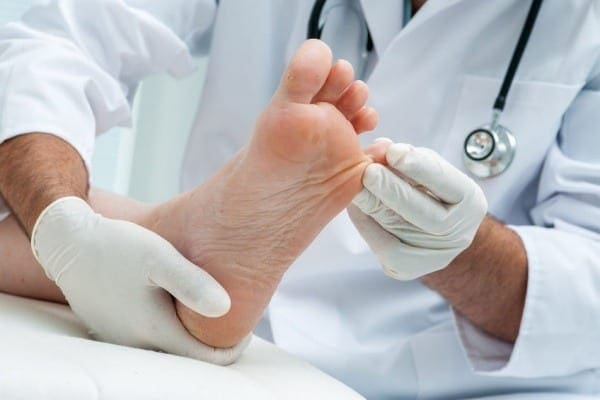
As most diabetics know, the condition causes the likelihood of foot infections arising much higher than those without diabetes. In this article, we’re going to go over the reasons as to why the risk increases through the existence of the disease.
Why is Diabetes Linked to Foot Infections?
Along with diabetes comes another condition, called peripheral artery disease (PAD). This sort of disease takes a toll on your arteries—narrowing them so that the flow of blood heading to your legs and feet is much less than before. This can lead to the appearance of ulcers and infections. The reduction of blood flow can also drastically slow up healing times, making you much more prone to ongoing injuries and foot infections.
However, this isn’t the only factor can lead to foot and leg infections.
Here are some other reasons why diabetics are more likely to get foot infections:
- Changes in the skin: Diabetes often can lead to the skin becoming much dryer than normal—through the nerves. Since the nerves are often responsible for bringing in oil and moisture, a reduction in this function can also lead to cracking and peeling of the skin.
Although it may be tempting, do not moisturize your feet with creams or oils—this can lead to infection. Instead, try a thin coat of plain petroleum jelly, an unscented hand cream, or more natural products. Also, soaking your feet can dry your skin out even more.
- Poor circulation: As previously discussed, a reduction of blood flow can make your feet weaker when fighting infection and can slow down the healing process. The condition actually hardens and narrows the blood vessels.
Although most of this factor is inevitable, you can try omitting behaviors in your daily life to not worsen the condition. For example, you can keep your cholesterol and blood pressure under control through a healthy lifestyle and diet and avoid smoking. A lack or reduction of blood flow can also lead to cramps and pain in your legs or feet.
- Improperly-fitting shoes can lead to ulcers: If you have diabetes, it is extremely important to make sure that your shoes are properly fitted and comfortable on your feet. If they are not, they can lead to ulcers, generally located on the ball of the foot or on the bottom of the big toe. If you notice ulcers on the sides of the foot, then they are most likely caused by your shoes. When left untreated, these ulcers can result in infections.
- Calluses can get out of control: In people with diabetes, you have a much higher chance of calluses building up on your feet because of the high-pressure areas under the foot. If you find that you’ve been getting calluses on a regular occurrence, speak to your doctor about the benefits of therapeutic shoes and inserts.
- Diabetes is linked to high blood pressure. High blood pressure is linked to: damage in the nerves and blood vessels in your body. Especially for the nerves located in the feet and legs, this damage can be especially dangerous since it prohibits feeling pain and other symptoms. This loss of feeling can lead to much bigger problems and medical issues. Even this seemingly small factor can lead to a serious infection or gangrene—the death of your tissue.
So, what can you do it?
We know now that diabetes can lead to an ample of foot problems. Although a lot of the factors are uncontrollable, there are some actions you can take to help avoid infections, other issues, and ultimately, amputation. Patients who suffer from diabetes are much more likely to have a foot or leg amputated. All the issues that may lead to ulcers and infections—especially when there is a loss of feeling—can also cause amputation to be needed. Here are a few to-dos to check off to make sure you’re trying to avoid those foot issues:
- Check your feet on a regular basis. Especially when there’s a loss of sensation, you might notice problems like cuts or sores. When you take off your shoes in the evening, do a quick check, on the bottom of your feet, the top, sides, and even in between your toes. You should be checking for cuts, sores, red spots, blisters, ingrown toenails, corns, calluses, plantar warts, athlete’s foot, and warm spots—among others.
- If you do notice any of these issues, cover the area with a bandage or smooth out corns or calluses. If you’re not sure about how to do so, contact your doctor about professional advice or attention.
- Invest in special therapeutic shoes, that can not only help you avoid calluses and blisters from forming but also a reduction in the re-shaping of your feet and toes that nerve damage can cause.
How to keep your legs healthy:
To help you keep your feet and legs healthy (and avoid a case where amputation is required) look out for a numbness sensation, a burning pain, an ache that’s not so sharp, a less-rough patch of skin, hair loss, a reduction in feeling, swollen ankles or feet, dryness and lack of sweat, certain wounds or cuts that won’t heal, and cramping.
Although those symptoms can be taken care of an easy-basis, there are some issues that should grant you into immediate care, like differences in the color and contours of your feet, getting cold feet (literally), blisters, sores, and cuts that are visible but have not feeling or a bad odor coming from a wound. These issues can be very dangerous for a diabetic. Making sure to stay on top of your foot health care is extremely important for your overall health and helping you avoid extreme measures like an amputation.
If there is any change in your health—take note! Have your doctor go through the symptoms you should personally look out for and try and get some therapeutic, personalized shoes to help you avoid a majority of these issues.

